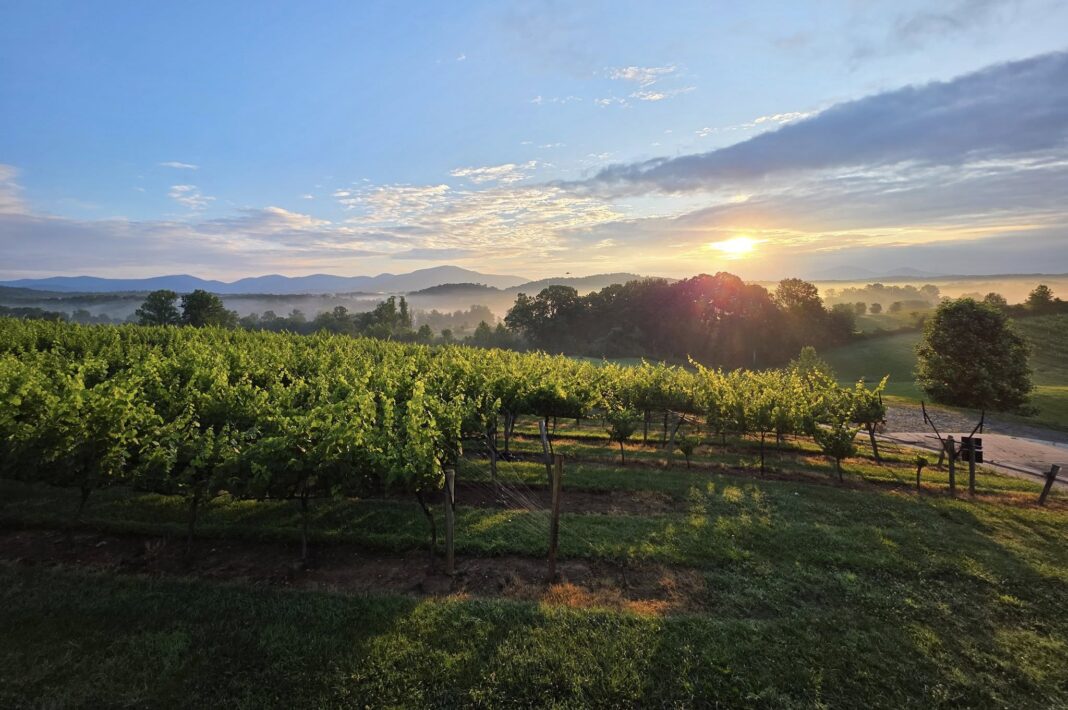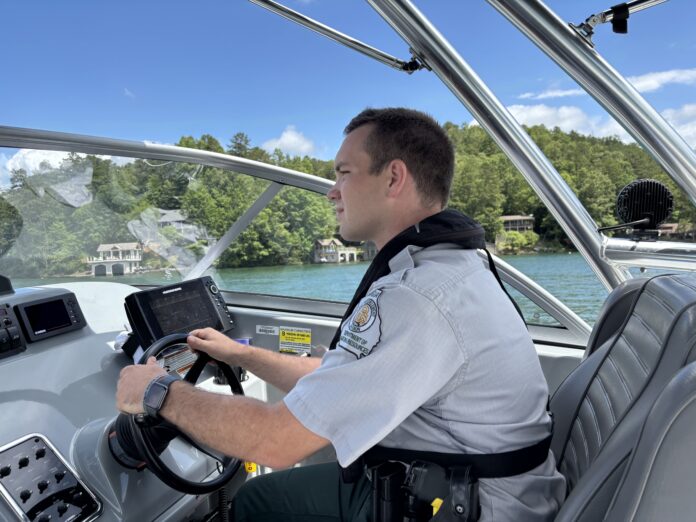Tucked into the ridges and red clay of Lumpkin County, the Dahlonega Plateau AVA—the state’s first federally recognized American Viticultural Area—offers more than views and tasting flights. It offers a promise: that what’s in your glass comes from the soil beneath your feet.
Few in the region fulfill that promise as fully as Kaya Vineyard & Winery, where the entire process—planting, pruning, harvesting, fermenting, bottling, pouring—happens on the property. Start to finish. Vine to vessel.
It isn’t easy. It isn’t cheap. And it isn’t the norm.
Across the state, wineries multiply with every season, many of them importing fruit or juice from California, Washington, and Spain. Some pour excellent wine. But only a small fraction meet the AVA’s thresholds—let alone grow, ferment, and bottle everything on site.
“It costs more, and it risks more,” says Kaya’s head winemaker Dominic, who insists his name only goes on bottles he controls from beginning to end. “But it’s the only way I know how to do it.”
North Georgia’s climate complicates the growing process. Spring frosts creep in after bud break. The soil, while rich, demands attention.
Farming grapes here costs about $7,000 per ton—more than double what it would take to truck in comparable fruit from Napa. And yet, Kaya, like a handful of others, continues to do it the hard way.
Because, like most Georgia farmers, they trust that the hard way is the right way—the only way worth doing when pride is on the line.
A rare micro-climate exists in Dahlonega
The Dahlonega Plateau earned its AVA status in 2018, making it Georgia’s first and only federally designated wine region. At elevations between 1,500 and 1,800 feet, the plateau sits just close enough to the Blue Ridge to capture cool breezes and just high enough to escape some of the Southern humidity that plagues vines in the Piedmont.
Mineral rich, well-draining soil, give grapes here a distinct character. Rainfall, while generous, doesn’t linger. These are not the sprawling vineyards of California or the lush riverbanks of Oregon. They are tightly managed rows, woven into the hillsides, protected by the manual labor of a dedicated crew.
North Georgia is home to hundreds of vineyards, but few operate at the level Kaya does. Many supplement with out-of-state juice, while others outsource bottling. Some are not wineries in the truest sense, but tasting rooms with decorative grapes on a trellis.
Kaya’s vineyard crew refuses shortcuts. Six full-time vineyard workers tend the land year-round. On frost-threatened nights, they fire up smudge pots to protect tender buds. They manually fertilize, monitor the soil, and prune each vine with the precision of craftsmen. It’s easy to picture gloved hands sculpting the twisting leaves along their trellises—lines of discipline and care drawn across the slope.
As one leans, glass in hand, against the balcony of the tasting room, Tuscany may come to mind, but this is Southern Appalachia, and the work here is as much about patience as it is about place. Block C, their most iconic chardonnay field, produces one of the largest estate-grown chardonnay harvests in the state.
A columned cottage
This cottage, located on the grounds of Kaya Vineyard & Winery in Dahlonega, offers a clean, modern take on a farmhouse aesthetic. The exterior features a broad front porch with white columns and rocking chairs, overlooking the vineyard rows that stretch into the hills. A concrete path curves through manicured grass toward neighboring houses and the tasting room beyond.
Inside, the kitchen balances utility with design. It includes stainless steel appliances, white shaker cabinets with glass uppers, a center island with seating for three, and a subway tile backsplash. Open shelves and a soft gray base on the island provide contrast to the otherwise all-white cabinetry. The space opens to a living room with cushioned seating, a round wood-and-metal coffee table, and a stacked stone fireplace. French doors lead to a back porch with views of the pond and vineyard.
The palette throughout remains muted—white walls, soft wood tones, and light upholstery—interrupted only by dark metal hardware and fixtures. Lighting is minimal and recessed, with a single, modest chandelier above the living area.
Bedrooms maintain the same clean lines. One features a tufted headboard set against a horizontal wood-plank accent wall. Another includes vaulted ceilings, a white ceiling fan, and barn-style sliding doors that open into a double-vanity bath. Finishes in the bathroom are simple: rectangular tile, quartz countertops, and unadorned mirrors.
The view remains the strongest feature. Through nearly every window, guests can see vineyard slopes, distant ridgelines, or the tree-framed pond below.
The cottage is quiet, practical, and well-positioned for guests who want privacy without losing proximity to the winery’s main buildings. It doesn’t overreach in style or service—but it doesn’t need to.
Asheville views in Dahlonega
I arrived at Kaya as a magazine editor, ready to observe vines and wines. But within moments, I shed the assignment and settled into something simpler: a mother grateful to trade the noise of a glow-in-the-dark musical cow for one clear hour of silence. I live in Habersham County now, but I grew up in Asheville, where the mountains shaped my sense of scale. They rose around me on all sides, defining the edges of every childhood memory.
As I settled into a cushioned lounge chair, taking in the long-range mountain views framed by rows of grapevines, Asheville came to mind with a clarity that surprised me.
On my first morning, I stepped outside modern farmhouse cottage to watch dawn break. The dew soaked my sandals as I walked from the house and paused at the edge of the street. A blush of pink and purple crept across the sky, and golden light knifed through the vines, gilding the grass while leaving the cattle pond steeped in darkness.
The contrast felt deliberate—a landscape painted in the style of a chiaroscuro. The vineyard rendered like a Caravaggio still life, where light and shadow compete for balance. Thus, evoking the Mediterranean while I turned over lines of Greek poetry in my head.
I changed into tennis shoes and walked to the tasting room. No one else stirred on the property. In that moment, I had the entire vineyard to myself. I bathed in birdsong, a constant at Kaya, and pulled my jacket tight against the chill. The sky shifted from blush to cornflower blue, and the vineyard and mountains responded in kind, showing first their softness, then their edge, and finally the hospitable hostess who greets visitors by early afternoon.
Like the velvet mills of northern Italy that still produce smoking jackets stitched in braided silk frogs and saddle-stitched lapels—pieces made not for mass production, but for the sheer pride of perfection—Kaya crafts wine for people who value quality.
Wine in North Georgia
Wine in North Georgia has never been simple. Settlers tried grape growing as early as the 19th century, with some success. But Prohibition dismantled the fledgling industry, and the landscape didn’t recover until the 1980s, when families and farmers gave it another try.
By the 1990s, various wine growers carved footholds into the red hills. But the turning point came in 2018 when the federal government designated the Dahlonega Plateau an AVA. Suddenly, the region was thrust onto the world stage. It was no longer just wine in Georgia. It was wine
from
Georgia—rooted and regulated.
Today, the region includes dozens of wineries, but only a handful operate entirely within the AVA and meet its strictest standards. Kaya stands among them, producing several thousand cases of wine each year.
The best charcuterie I have ever tasted, Kaya Vineyards & Winery / The Cute North Georgian Magazine
Why it matters
It’s easy to pour a good wine. It’s harder to pour a true one.
AVA labels help to articulate to visitors and assure them of the highest quality grapes and means of production. To bear the name “Dahlonega Plateau,” a bottle must contain at least 85% grapes grown within the AVA’s boundary. The wine must also be bottled in the state of origin. These regulations protect consumers and honor the land. But they can’t guarantee that the winemaker chose passion over profit.
That’s something you have to taste for yourself.
At Kaya, you can.
You can see the grapes from your seat. You can walk the rows. You can watch the bottling happen just down the hill. You can speak to the winemaker.
And if you’re lucky, you can stand at the edge of the field at dawn and watch the light climb the ridge.
That’s the kind of truth you can’t bottle anywhere else.
Carly McCurry is the publisher of
The Cute North Georgian
magazine. Her work appears on NowHabersham.com in partnership with Now Network News.

 by
by 

